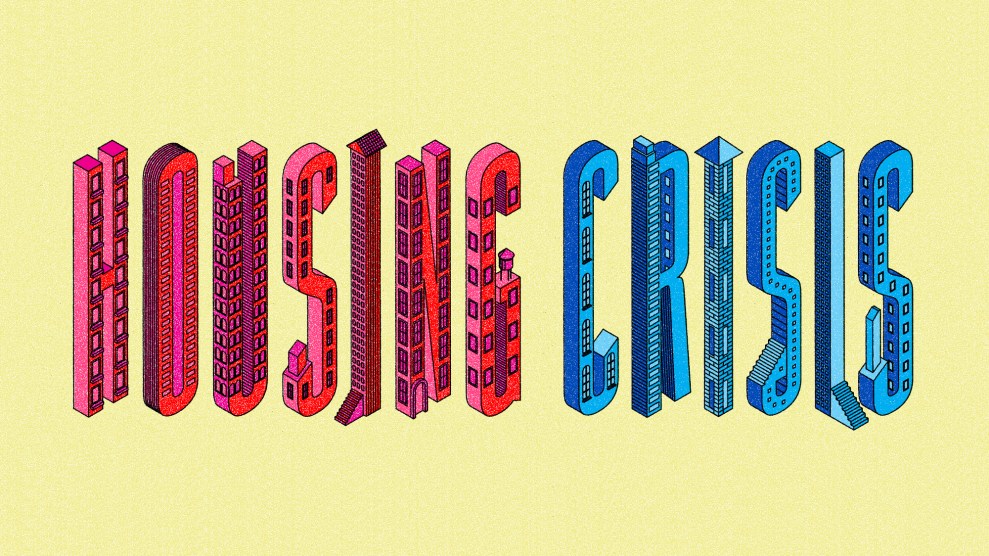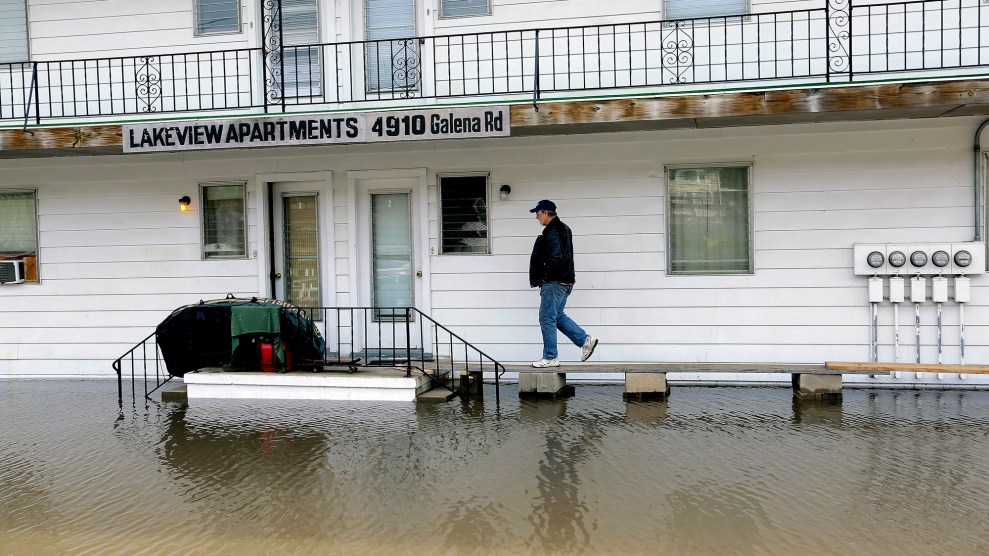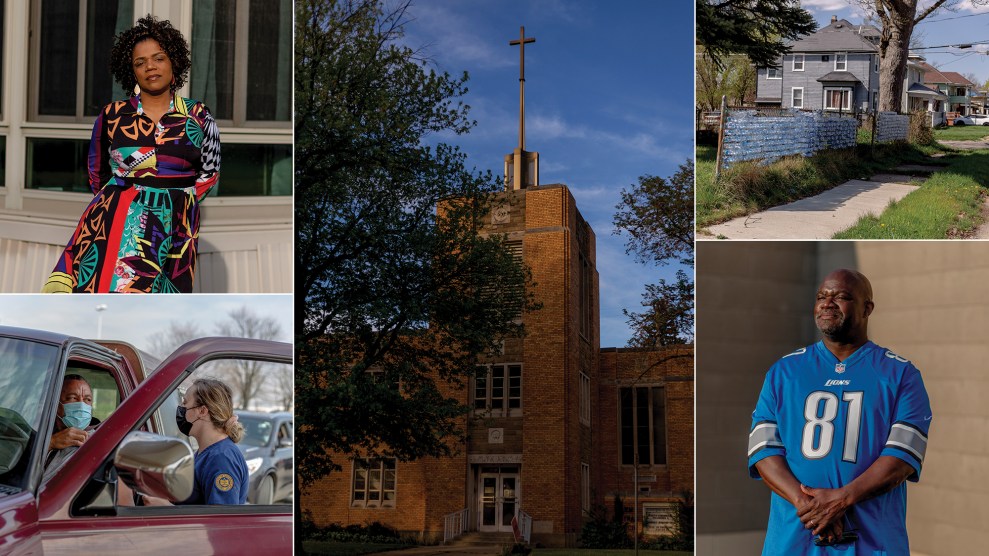In December 2020, three months after his family received an eviction notice from their landlord, Gabriel Guzman felt a bitter mix of sorrow and anger as he and his wife, Elena Porras, gathered with friends at their Chula Vista, California, home to pack up their belongings. They had two days before sheriff’s deputies might arrive to lock them out of the white-paneled, single-story, three-bedroom house they’d rented for just over a year. Guzman himself had been living in Chula Vista since 2000. After serving in the Marines at Camp Pendleton and then as a reservist, he worked as a property manager for over a decade—first with mom-and-pop real estate firms and later with larger ones.
So when his family received the eviction notice in the midst of the pandemic, he felt better equipped than most tenants to deal with it: When his landlord, Arturo Ruiz, filed the eviction lawsuit in court, Guzman paid an attorney to represent the family. He showed me copies of signed hardship declarations he said he’d sent Ruiz, a broker for Premier Properties, which managed the property, each month from September to December, stating that his family was unable to pay rent “due to financial distress arising from and/or related to COVID-19.” (A cover sheet for the legal action indicated, under penalty of perjury, that the landlord did not receive Guzman’s declarations.) Asked about the discrepancy, Rachael Callahan, an attorney for the landlord, responded, “In this case because the lease had expired they were no longer tenants.” Unfortunately for Guzman, the state eviction moratorium would only protect him if he’d been evicted for failing to pay rent due to Covid hardships. The rule doesn’t require a landlord to renew an expiring lease. Callahan added about the case: “This was a straightforward case where the tenants signed a contract specifying they would leave on a certain date [sic], and then they did not leave.”
“I was thinking that I was doing the right thing for my family, taking care of them, keeping a roof over their head, and then all of a sudden, I find myself floating our furniture and everything else, wondering where to go,” Guzman recalls.
As the case stretched on without resolution and the lockout deadline loomed, Guzman and Porras decided, for the sake of their three children, that they needed to move out. “It was chaotic,” he says.
So they left their kids with friends at a nearby Red Roof Inn while they packed family memories into boxes and cleaned the house. They didn’t finish until two in the morning, when, after he and Porras said their goodbyes to the house and drove off, Guzman realized he’d left something precious behind: the Marine Corps sword he wore as a non-commissioned officer. “I had to run all the way back in. We were exhausted,” he says. He crawled under the broken garage door to retrieve it. “My wife started crying. She’s like, ‘I can’t do this anymore.’”
That family’s fateful lockout notice, administered just before the winter holidays amid the pandemic, was an upheaval familiar to hundreds of thousands of American households on the lower tiers of the economic spectrum that struggle to pay the bills even during good times. It hardly mattered that the federal government and California both had enacted pandemic eviction moratoriums. A Mother Jones analysis of census data and sheriff’s department lockout notices in five California counties from March 13, 2020, to October 2021 found that even as evictions proceeded at lower rates during the pandemic, they continued to disproportionately affect residents of majority-Latino and majority-minority neighborhoods.
Factoring in eviction threats and informal proceedings, the toll is unquestionably far greater. Matthew Desmond, a Princeton University sociologist and author of the Pulitzer Prize–winning book Evicted, determined that lockout notices in Milwaukee County, where he conducted research, represented just a quarter of all forced moves. Informal evictions were roughly twice as common as official ones, though harder to track.
Our analysis found that in San Diego County, which is home to Chula Vista, families living in majority-Latino neighborhoods, like the Guzmans, faced a lockout rate of just more than four units for every 10,000 men, women, and children—17.7 percent higher than that experienced by people in majority-white neighborhoods.
This pattern held true in other California counties we examined: In Contra Costa County, an increasingly diverse smattering of suburbs east of San Francisco, people in Latino-majority neighborhoods experienced 46 percent higher lockout rates than those living in white neighborhoods. In majority-minority areas, lockout rates were slightly higher.
Several experts I reached out to noted that these findings mirror national trends: In an analysis of millions of court records across 31 cities and six states, researchers from Princeton’s Eviction Lab concluded that Black and Latino renters overall, and particularly women, faced a disproportionately high risk of being evicted. “It’s a pattern that we’ve seen during the pandemic,” noted Peter Hepburn, an assistant professor of sociology at Rutgers University, Newark, and a research fellow at the Eviction Lab.
Research on the lingering health effects of eviction on children and adults underscores a bitter reality: As evictions increase, Black and Latino renters and their families will carry a particular mental and physical burden, both short and long term. The portrait of disparate impact is complicated: In a preliminary analysis of court filings in December 2020, the Eviction Lab found that Black renters, who were overrepresented in eviction filings before Covid came along, remained overrepresented during the pandemic, while Latino and Asian renters were underrepresented that year.
This, according to Kathryn Leifheit, a social epidemiologist and postdoctoral fellow at UCLA’s School of Public Affairs who studies the health effects of evictions on young adults, suggests that Latino renters, particularly when undocumented, are “more subject to pressure from landlords to move, and threats of eviction without necessarily a legal filing.” All of which makes it more challenging for researchers to measure the full extent of the problem.
“While fewer cases than normal have been filed over this period, the populations at risk of eviction have not substantially changed,” the Eviction Lab analysis notes. “Rather, the threat of eviction is concentrated among those for whom displacement was an all-too-common risk before the pandemic began.”
Forcing families from their homes, research shows, creates much more than an inconvenience. “It is critical to underscore that these evictions don’t just represent lost housing. Evictions have wide-reaching impacts on families and communities,” Gabriel Schwartz, a social epidemiologist and postdoctoral fellow at the University of California, San Francisco’s Social Policies for Health Equity Research Program, told me via email. Schwartz, who also studies the health effects of uprooting a family, adds that evictions “represent acute financial shock, displacement, social network disruption, and psychological stress.”
Guzman has experienced that stress more than once. His family managed to find another rental home in January 2021, about a month after they were first evicted. But then, earlier this year, he returned from a store one day with his second-oldest daughter to find his wife coming out of the house to meet them. He sensed something amiss. Indeed, it had happened again. They’d received a 60-day notice to vacate. Members of the landlord’s family planned to move into the house. Hearing the news, Guzman felt “numb.” He asked himself, “‘What the hell is going on?”
Based on the data Mother Jones obtained, the burden of pandemic-related housing instability is shared unevenly, depending on the racial makeup of one’s neighborhood. Just as Covid death rates and job losses have been far higher than average within communities of color, so too are the odds of being displaced. Across all five California counties we reviewed, 1.27 lockouts occurred in majority-Latino neighborhoods for every one in a majority-white neighborhood.
The Eviction Lab’s Hepburn points out that Black and Latino renters are more likely to work in lower-paying jobs, particularly in the service sector. Those “essential” jobs were among the hardest hit in the early days of the pandemic. And workers of color are less likely than white workers to have sufficient savings—or family wealth—to cushion them during periods of economic instability.
“Beyond the strictly economic factors, there is also this possibility that landlords are just quicker to evict people of color than they are white people,” Hepburn added. “That sort of discrimination explanation is pretty hard to discount. But it's also hard to prove.” The Eviction Lab found, however, that anywhere from one-fifth to one-half of pandemic eviction filings came from a small number of apartment buildings owned by large landlords, including private equity investors.
The data Mother Jones analyzed does not specifically show that Black and Latino renters face higher lockout rates, because sheriff’s departments provide only the names of plaintiffs and defendants and the address where a notice was served. But those locations hint at disparities that are particularly problematic in regions where soaring home prices and escalating rents have displaced some groups far more rapidly than others. And “when we talk about mental health effects of evictions, that pretty much necessarily means that [those effects are] disproportionately borne by Black and Latino communities,” says UCLA’s Leifheit.
During the eviction process itself, tenants are badly outgunned. Just 10 percent of renters have access to legal counsel, according to Desmond’s research, compared with 90 percent of landlords, a stark power imbalance. A movement is afoot in cities such as Cleveland, New Orleans, and San Francisco to guarantee tenants legal assistance in housing disputes. The authors of a new working paper from the National Bureau of Economic Research report that, after New York City implemented such a program, tenants who participated were “less likely to be subject to possessory judgments, face smaller monetary judgments, and are less likely to have eviction warrants issued against them.”
Tim Thomas, research director at the Urban Displacement Project, an initiative out of University of California, Berkeley, and University of Toronto, and his team have analyzed eviction filings in the Bay Area, Baltimore, and Washington state. In Baltimore, they noticed that evictions tended to concentrate both in places that are highly segregated because of historic redlining, and in places where Black households relocate after being displaced. Evictions are also relatively high in displacement destinations in the Bay Area, according to a risk model Thomas’ program developed. That is, Black and Latino families who priced out of fast-gentrifying San Francisco and Alameda counties end up moving to lower-priced communities in Santa Clara and Contra Costa counties where rates of eviction are high. “This tells me that evictions are a civil rights issue,” Thomas says, “because what created these neighborhoods are part of the legacy of what segregation did.”
The disparate affliction of communities of color, whether from the mere threat of eviction, the physical dislocation, or its aftermath, filters into other facets of life, especially for families with children. Children's HealthWatch, a network of pediatricians and public health researchers based at Boston Medical Center, found that the proportion of families with young children that experienced food insecurity and an inability to pay their rent increased significantly during the six months of the pandemic the group examined.
Immigrant mothers with children were four times as likely as before the pandemic to fall behind on rent, the HealthWatch report also noted. Meanwhile, a study published in October 2020 by Cleveland State University’s Megan Hatch and Jinhee Yun found that tenants “even eight years after an eviction” were more likely to report that they were in poor health or experiencing mental health problems. “Those poor health outcomes (and the costs they entail) can lead to future evictions, creating a cycle of disadvantage,” UCSF’s Gabriel Schwartz wrote to me. “When we talk about racial inequities in eviction, we are really talking about racial inequities in health, cognition, well-being—about structural racism creating harm through the holes in our housing safety nets.”
A growing body of evidence shows that evictions and housing instability also affects development in young children. Pregnant women who have been evicted are at a higher risk for underweight newborns and premature births, not to mention a greater likelihood of household food insecurity. In a January 2022 study published in the journal Social Science & Medicine, Leifheit, Schwartz, and others analyzed data from the Fragile Families and Child Wellbeing Study, a national study that tracked the outcomes of infants born from 1998 to 2000. Those whose families were evicted during their infancy scored lower on cognitive assessments for executive functioning, mathematical reasoning, and language skills, even years after the disruption in their parents’ lives.
Separate research by Leifheit, Schwartz, and others found, not surprisingly, that the expiration of eviction moratoriums leads to higher risk of Covid cases and deaths among renters, and that the affliction is unevenly felt. They observed “kind of modest increase” among white renters, Leifheit says, “but then very, very steep increases among Black and Latino people, suggesting that the evictions that happen when moratoriums expire are concentrated in Black and Latino communities.”
A lot of the racial and ethnic disparities in eviction filings, and the downstream health outcomes, “ties back to structural racism,” she adds. “Black and Latino people have been left out of housing markets and homeownership. So they're disproportionately represented in rental markets, and then much more subjected to the volatility that we see in rental markets.”
Guzman’s family spent Christmas 2020 at an Airbnb in North Park, 10 miles from the home they were evicted from. He and Porras wanted to stay positive for their kids, who were still too young to truly understand their circumstances.
Their then-10-year-old daughter grew clingier than usual, Guzman noticed, whereas their 6-year-old son, the same kid “who forgets he was in trouble,” he jokes, seemed almost oblivious. The couple’s 4-year-old daughter, though, began to wake up in the middle of the night and scurry to her parents’ bed because “she was in places she didn’t recognize.”
Guzman also has a 20-year-old daughter from an earlier marriage, who lives with her mother and worries about her young siblings. Porras got sick after the first eviction, Guzman told me, not from Covid but from the stress of the ordeal. As for himself, “I had a lot of feelings, but the worst one is I felt that I had failed my kids.”
A self-described farm boy, Guzman, who is Mexican American, was one of eight children raised by his parents in Imperial Valley, where his father worked as a sanitation worker for 30 years: “I grew up poor. When I was growing up, my dad only went to work. But never, never, never, in the 18 years in the Valley did I ever remember having the fear of not having a roof over my head.”
He tried to do everything right. After moving to Chula Vista, he found work as a property manager, married his first wife, and had a kid. He attended night school at Southwestern College and took online classes. He later opened cleaning and restoration businesses, worked as a real estate agent for a time, and bought a house he had to sell for the divorce. In his 13 years of property management experience, “the eviction process for us was one of last resort,” he recalls. “We always give the benefit of the doubt. We work with people.”
Evicting a tenant is expensive for smaller landlords, between legal fees, forsaken rent, and the risk of property damage by a disgruntled tenant. But working with larger companies, he observed a lack of concern for the tenant-owner relationship. “They didn't care. They’d evict people on a dime,” he says. “I couldn't stomach that.” That disconnect, Guzman explains, compelled him to give up his property management work around 2006.
But the pandemic left his family on the other side of a difficult tenant-owner relationship. In March 2020, he lost his job as a salesperson for a different restoration company. To make ends meet, he drove for Lyft. Two months later, his wife lost her position as a day care teacher. They had some savings and had applied for unemployment benefits, but ran into a minefield of bureaucratic delays: Guzman couldn’t get anyone on the phone.
He consulted a local elected official who helped him sort out the reason for the delay, but he had to refile for unemployment. He then missed a phone call when the agency was trying to verify his identity. They kept paying rent through all of that, but by August 2020, he and Porras had run out of rent money. That month, his landlord, Art Ruiz, served him with a notice that he would not renew Guzman's lease. The next month, he gave his landlord the hardship declaration hoping it would help. Ruiz's attorney filed an unlawful detainer lawsuit claiming Guzman and Porras overstayed their lease. When the eviction notice arrived, Guzman tried to fight back by arguing he was not given the 30-day notice of nonrenewal as required by law. In the final ruling in November 2020, San Diego County Superior Court Judge Timothy Taylor concluded that the Tenant Protection Act did not cover Guzman’s family because they had not lived in the house “continuously and lawfully” for 12 months, since the lease technically ended one minute before the year mark. “Defendants failed to raise a triable issue of material fact,” he added. “Their sole argument—a claim that Civil Code section 1942.2 protects them—is unavailing.”
In the meantime, the couple’s credit took a hit, making it harder to get past initial screenings for housing rentals.
“I didn’t understand,” Guzman says, how someone could just evict a family: “For me to have to face it after I served this country—I was a decent person just trying to raise my kids, I could never put myself in [that] situation, with no remorse. They went ahead and did it.”
When I told him of the disparities I’d seen in his county’s lockout data, Guzman wasn’t surprised. There had been seven lockout notices in his old neighborhood over the past two years. Latinos “are the ones that established Chula Vista as renters,” he says. “And they’re the ones who are being pushed out.” Thinking back on his property manager days, “it makes sense. The people are being priced out...If you're working very hard to just pay your rent, you're not going to have the money to get representation. So either you’re gonna move out or you're going to be locked out.”
For Guzman and his family, it has been another race against the clock. At the end of March, the state legislature extended eviction protections for people who had applied for rental relief (including Guzman, though he has yet to receive that relief). Days later, the San Diego City Council extended a moratorium on no-fault evictions—but that doesn’t help Guzman, who lives outside of city limits. He’s been phone-banking with a group called the Alliance of Californians for Community Empowerment Coalition, trying to push for similar protections in Chula Vista. But recently, even as a new attorney provided by the group argued that the new landlord’s eviction notice was “defective,” the couple received official word that the landlord is suing to evict them. Guzman has since decided to file for bankruptcy, which he says will put the current eviction on hold for 90 days.
They’ve considered leaving California altogether. Guzman has a sister in Nevada and military friends in Texas. He’d like to stay, but he and Porras have other priorities. “We'll see where we're at on the other side of this,” he says. “Right now I have to focus on keeping a roof over my kids’ head and keeping them safe.”
This article was supported by the USC Annenberg Center for Health Journalism’s 2021 Data Fellowship.

















